Introduction: As cities expand and change, there is a rising need for innovative and sustainable solutions. Smart city lighting systems are one area where technological improvements, especially those related to artificial intelligence (AI), are having a significant influence. Lighting systems with AI capabilities are reshaping urban environments and improving safety, energy efficiency, and general quality of life. This blog article examines how AI is used in smart city lighting and how it can influence urban environments in the future.
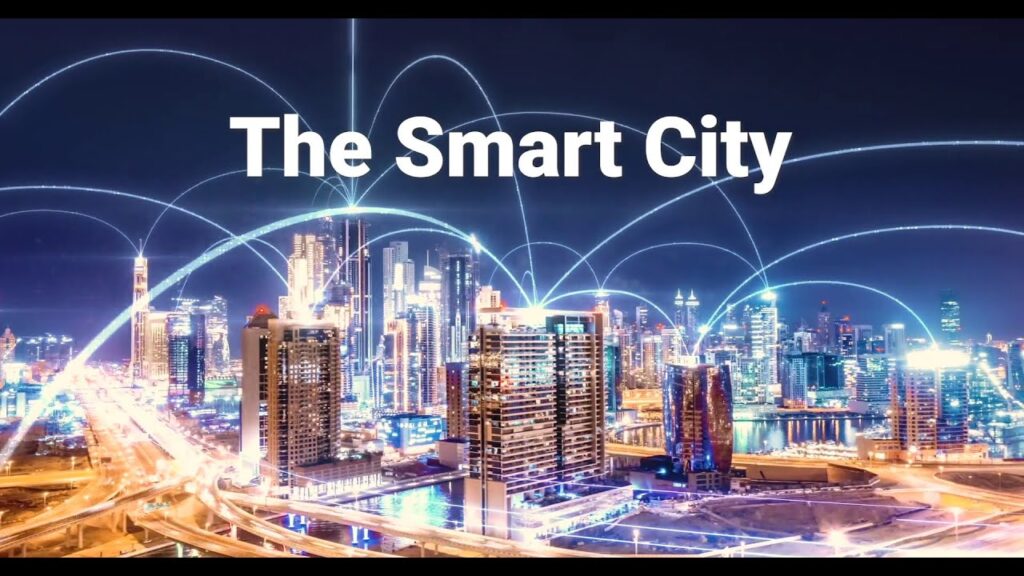
1. Smart City Lighting: Transforming Urban Environments
By utilising cutting-edge technology and sophisticated systems to create surroundings that are safer, more effective, and more environmentally friendly, smart city lighting is revolutionising metropolitan areas. Smart city lighting is emerging as a game-changing solution as cities continue to expand and confront several issues, including rising energy needs, safety concerns, and the desire for enhanced quality of life. Let’s see how urban areas are being transformed by smart city lighting:
Energy Efficiency: Because of their old technology and ineffective functioning, traditional lighting systems frequently use too much energy. Energy-saving LED fixtures that can be dynamically regulated and modified based on current conditions are used in smart city lighting. To optimise lighting settings, save energy use, and reduce light pollution, AI algorithms analyse data from sensors such as motion detectors and ambient light sensors.
Intelligent Lighting Control: Intelligent lighting control systems are integrated into smart city lighting, allowing for precise administration of the lighting infrastructure. Remote control of individual or group lights is possible thanks to centralised control systems. Adaptive lighting control ensures the best illumination when and where it’s needed by adjusting lighting settings based on variables including foot traffic, weather, and time of day.
Safety and Security: Smart city lighting makes metropolitan areas safer and more secure. Intelligent street lighting that automatically adjusts brightness in reaction to human presence is made possible by motion sensors and video analytics, encouraging well-lit and secure surroundings. AI-integrated video surveillance systems may identify and notify authorities of possible security concerns or odd activity, facilitating efficient crime prevention and emergency response.
Making decisions based on data: Smart city lighting systems collect a tonne of data from sensors and linked devices. This data is analysed by AI algorithms to yield useful insights for managing and developing metropolitan areas. City officials can optimise lighting methods, spot locations that need upkeep or modification, and anticipate public wants and preferences by using data-driven decision-making.
Enhanced Quality of Life: Smart city lighting strives to enhance both inhabitants’ and tourists’ quality of life. Individuals may modify lighting levels and colour temperatures in accordance with their demands thanks to personalised lighting preferences, which are facilitated via smartphone applications or IoT devices. Urban places are made more aesthetically pleasing by artistic lighting installations and architectural illumination, which also create situations that are visually stimulating and encourage cultural activities.
Environmental Sustainability: By lowering energy usage and light pollution, smart city lighting prioritises environmental sustainability. Cities may dramatically lower their carbon footprint by installing energy-efficient LED lights, enhancing lighting schedules, and adjusting illumination levels using AI algorithms. Additionally, smart city lighting reduces glare and light leakage, conserving the natural night time environment and safeguarding animal habitats.
Future Scalability and Integration: Scalability and adaptability to new technologies and breakthroughs are key features of smart city lighting systems. They can easily be integrated with other smart city programmes, including infrastructure management, environmental monitoring, and transportation systems. Greater efficiency, resource optimisation, and enhanced overall urban government are all made possible by this connection.
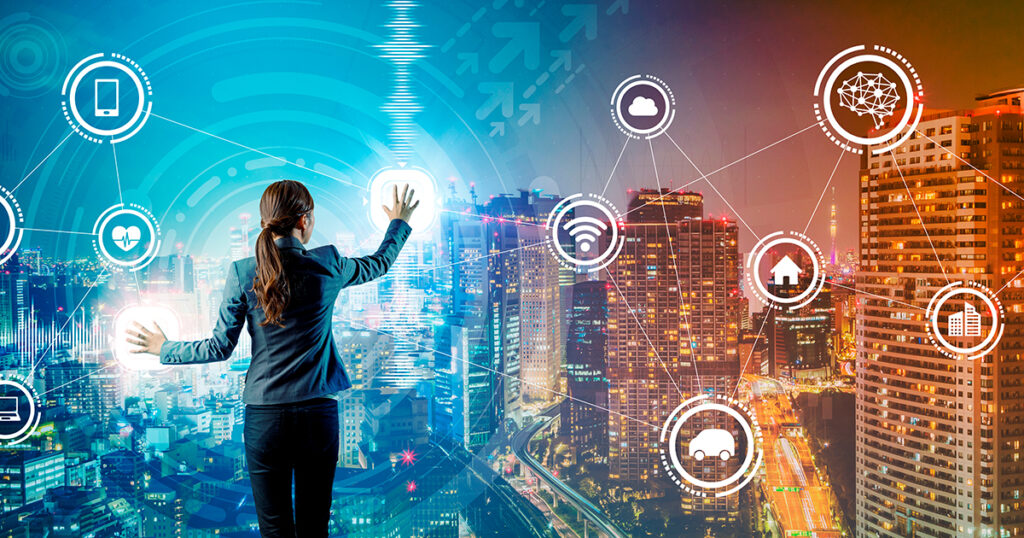
2.Smart City Lighting and the Power of AI
In smart city lighting, artificial intelligence (AI) has tremendous power, spurring innovation and altering how urban lighting systems function. In order to improve efficiency, make decisions in real time, and respond intelligently, AI provides complex algorithms, data analysis, and machine learning skills for smart city lighting. Let’s investigate the main features that bestow the power of AI on smart city lighting:
AI algorithms analyse the enormous volumes of data that sensors and linked devices in smart city lighting systems create. They are capable of deriving useful insights from complicated data patterns, correlations, and interpretations. This data analysis enables informed decision-making, including scheduling lights more efficiently, anticipating maintenance requirements, and adjusting lighting settings in response to environmental circumstances.
Real-time Monitoring and Control: AI empowers real-time monitoring and control of smart city lighting infrastructure. Through constant data analysis and feedback loops, AI algorithms can dynamically adjust lighting parameters to ensure optimal illumination levels based on specific conditions. For example, during periods of low pedestrian activity, AI can dim or turn off lights in certain areas to conserve energy while maintaining adequate safety.
Adaptive Lighting Solutions: AI enables adaptive lighting solutions that respond to changing environmental factors. By integrating AI algorithms with sensors that detect motion, ambient light levels, and other relevant parameters, smart city lighting systems can dynamically adjust brightness and colour temperature. This adaptability ensures that lighting meets specific needs, such as increased illumination in busy areas or dimming during late-night hours.
Predictive Maintenance: AI algorithms can analyse data from smart sensors embedded within lighting fixtures to predict maintenance needs and proactively address potential issues. By monitoring factors like bulb life, energy consumption patterns, and performance trends, AI can schedule maintenance activities, minimizing downtime and improving overall reliability. Predictive maintenance also helps optimize resource allocation, reducing costs and improving operational efficiency.
Energy Optimization: AI plays a crucial role in optimizing energy consumption in smart city lighting. By analysing data on lighting demand, occupancy patterns, and environmental conditions, AI algorithms can dynamically adjust lighting levels, schedule dimming or turn-off periods, and optimize energy usage. This not only reduces energy waste but also contributes to cost savings and environmental sustainability.
Intelligent Decision-making: AI enables smart city lighting systems to make intelligent decisions based on real-time data analysis. For example, AI algorithms can adjust lighting in response to sudden weather changes, traffic congestion, or safety concerns. By analysing various data sources and considering multiple factors simultaneously, AI helps create responsive and adaptive lighting systems that enhance safety, comfort, and energy efficiency.
Continuous Learning and Improvement: AI systems in smart city lighting have the ability to continuously learn and improve over time. By gathering data from various sources, including user feedback and historical performance, AI algorithms can refine their predictions, adapt to changing conditions, and optimize lighting strategies accordingly. This iterative learning process leads to increasingly accurate and efficient lighting solutions.
- 3. Illuminating Efficiency: Enhancing Energy Consumption
In the realm of smart city lighting, one of the primary objectives is to enhance energy consumption by implementing efficient lighting solutions. By leveraging advanced technologies and intelligent systems, smart city lighting aims to optimize energy usage without compromising safety or the quality of illumination. Let’s delve into the various ways in which smart city lighting enhances energy consumption:
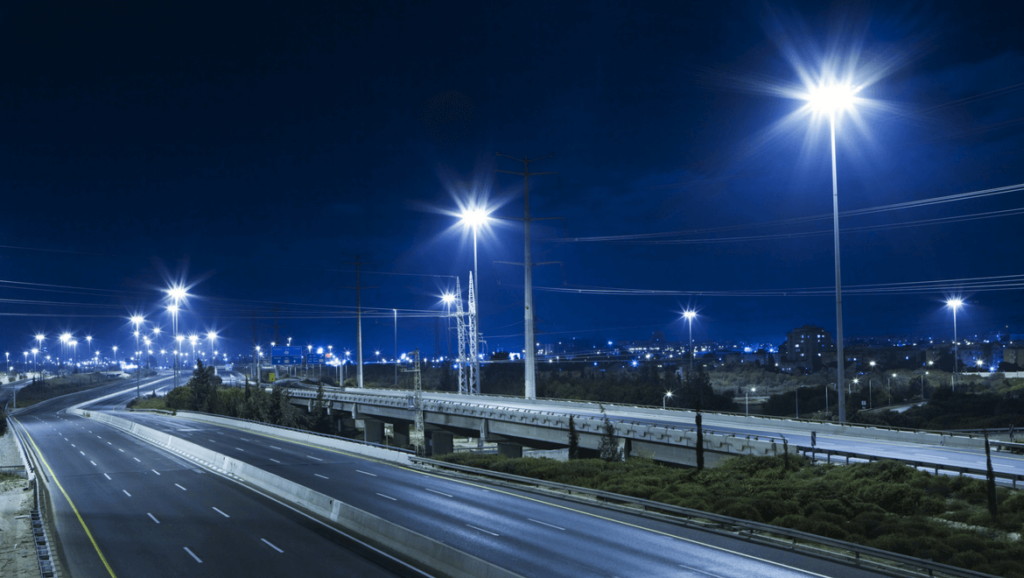
LED Technology: Light Emitting Diode (LED) lighting forms the backbone of energy-efficient smart city lighting. Compared to traditional lighting technologies like incandescent or fluorescent bulbs, LEDs consume significantly less energy while providing the same or even higher levels of brightness. They are highly efficient, have longer lifespans, and can be dimmed or controlled to adjust lighting levels as needed.
Adaptive Lighting Control Systems: Smart city lighting incorporates adaptive lighting control systems that intelligently adjust lighting levels based on real-time conditions. These systems utilize sensors, such as motion detectors and ambient light sensors, to detect occupancy, pedestrian movement, and natural light levels. By dynamically dimming or turning off lights in areas with low activity, energy consumption can be reduced while maintaining sufficient illumination.
Demand-Based Lighting: Smart city lighting systems can respond to demand fluctuations by providing lighting only when and where it is needed. For example, in areas with minimal or no activity during specific hours, lighting can be scheduled to turn off or operate at lower intensities. By aligning lighting operations with actual demand, energy waste is minimized, leading to substantial energy savings.
Dynamic Lighting Schemes: Smart city lighting allows for the implementation of dynamic lighting schemes that adapt to changing requirements throughout the day. AI algorithms analyze data from various sources, such as traffic patterns, weather conditions, and events, to determine optimal lighting configurations. This flexibility enables lighting systems to provide adequate illumination while conserving energy during off-peak periods.
Predictive Maintenance: Smart city lighting systems leverage AI algorithms to predict maintenance needs, reducing energy waste caused by faulty or inefficient components. By continuously monitoring performance data, such as energy consumption, bulb health, and connectivity, AI can detect anomalies and schedule maintenance activities proactively. Timely repairs and replacements prevent energy loss due to malfunctioning equipment.
Energy Optimization Analytics: AI algorithms analyse vast amounts of data collected from smart sensors and devices to identify energy-saving opportunities. By examining historical usage patterns and environmental factors, AI can optimize lighting schedules, adjust dimming levels, and implement energy-saving measures in real-time. These analytics enable intelligent energy management strategies tailored to specific urban contexts.
Integration with Smart Grids: Smart city lighting systems can integrate with smart grids, enabling bidirectional communication and energy management. By leveraging real-time data from the smart grid infrastructure, lighting systems can respond to peak energy demand periods by reducing lighting intensities or adjusting operational parameters. This demand response capability contributes to overall energy efficiency and grid stability.
Citizen Engagement and Awareness: Smart city lighting encourages citizen engagement and awareness by providing access to real-time energy consumption data. By enabling individuals to monitor their own energy usage and make informed choices, residents can actively participate in energy conservation efforts. This increased awareness and involvement foster a culture of sustainability and encourage responsible energy consumption habits.
- 4. Enlightening Safety and Security
Ensuring safety and security is a paramount concern for urban environments, and smart city lighting plays a crucial role in addressing these challenges. By integrating advanced technologies and intelligent systems, smart city lighting enhances safety, deters criminal activities, and provides a secure environment for residents and visitors. Let’s explore the various ways in which smart city lighting enlightens safety and security:
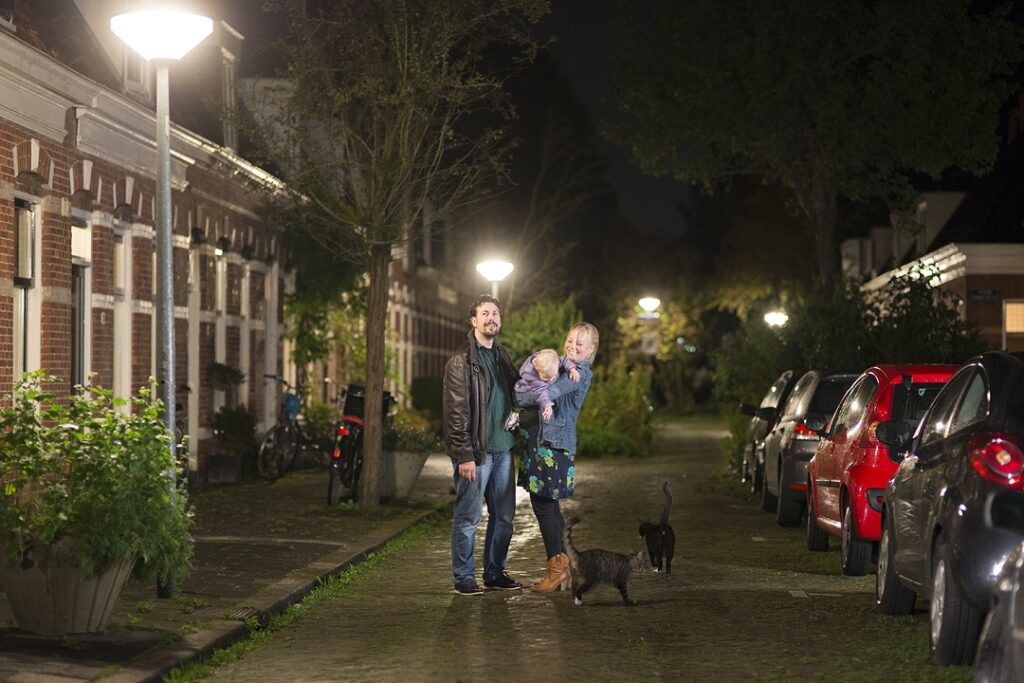
Enhanced Visibility: Smart city lighting systems significantly improve visibility in public spaces, streets, and pathways, enhancing safety for pedestrians, cyclists, and drivers. By deploying energy-efficient LED fixtures that provide high-quality illumination, smart city lighting ensures that key areas, such as intersections, sidewalks, and parking lots, are well-lit and free from dark spots. This improves situational awareness, reduces accidents, and minimizes the risk of tripping and falling.
Intelligent Street Lighting: Intelligent Street lighting, a key component of smart city lighting, utilizes sensors and AI algorithms to optimize lighting levels based on real-time conditions. Motion detectors and occupancy sensors detect human presence and automatically adjust the brightness of streetlights, conserving energy during periods of low activity. This adaptive lighting approach not only saves energy but also contributes to safety by ensuring well-lit streets where and when they are needed the most.
Video Analytics and Surveillance: Smart city lighting can be integrated with video surveillance systems and AI-powered video analytics. By combining lighting infrastructure with video cameras and intelligent algorithms, authorities can monitor public spaces, detect suspicious activities, and respond promptly to security threats. Video analytics can identify abnormal behaviour patterns, recognize objects or individuals of interest, and generate alerts for further investigation, enhancing overall safety and security in urban areas.
Crime Deterrence: Well-illuminated spaces are known to deter criminal activities. Smart city lighting, with its ability to adjust lighting levels based on real-time conditions, ensures that public areas are adequately illuminated, discouraging potential offenders. Bright and properly lit streets and public spaces create a perception of safety, promoting a sense of security among residents, workers, and visitors, and reducing the occurrence of crimes like theft, vandalism, and assault.
Emergency Response and Assistance: Smart city lighting systems can be integrated with emergency response systems to provide quick assistance during critical situations. In case of emergencies, such as accidents or incidents requiring immediate attention, smart lighting infrastructure can be programmed to flash or change colour, guiding emergency services to the precise location. Additionally, connected lighting systems can transmit emergency alerts, enabling timely and effective communication during crisis situations.
Geo-Fencing and Intrusion Detection: Smart city lighting can be equipped with geo-fencing capabilities, using geolocation technologies to define virtual boundaries around specific areas. If unauthorized entry or movement is detected within these boundaries, smart lighting systems can trigger alarms, change lighting patterns, or notify authorities. This proactive approach to intrusion detection improves security and enables a rapid response to potential threats.
Remote Monitoring and Management: Smart city lighting systems allow for remote monitoring and management of lighting infrastructure. Through centralized control systems, authorities can monitor the status, performance, and energy consumption of lighting fixtures in real-time. This enables timely maintenance and ensures that lights are functioning optimally, avoiding situations where faulty or malfunctioning lights create dark areas that compromise safety.
Integration with Public Safety Systems: Smart city lighting can be seamlessly integrated with other public safety systems, such as emergency call boxes, public address systems, and surveillance cameras. This integration enables a coordinated response to safety incidents, allowing authorities to gather information, analyse data, and take appropriate action swiftly. By creating a network of interconnected safety systems, smart city lighting contributes to a comprehensive and efficient safety infrastructure.
Citizen Engagement and Reporting: Smart city lighting systems can empower citizens to actively participate in safety and security initiatives. Integrated mobile applications or online platforms can enable residents to report
- 5. Enlightened Urban Experience: Enhancing Quality of Life
Smart city lighting not only focuses on energy efficiency and safety but also aims to enhance the overall quality of life for residents and visitors. By incorporating advanced technologies and intelligent systems, smart city lighting creates vibrant, aesthetically pleasing environments that promote well-being, foster community engagement, and offer memorable urban experiences. Let’s explore how smart city lighting enlightens the urban experience and enhances the quality of life:
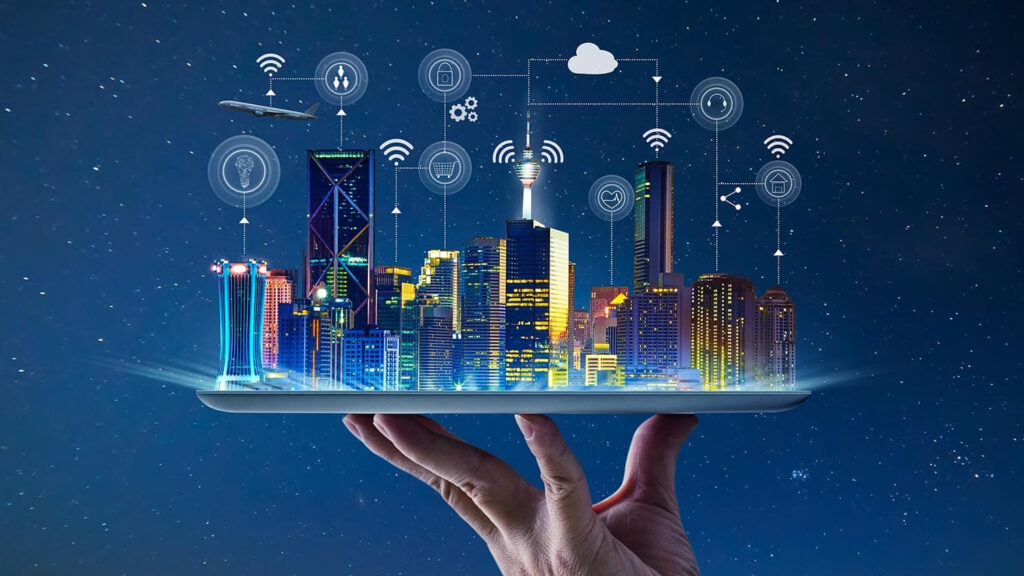
Personalized Lighting Preferences: Smart city lighting allows individuals to personalize their lighting preferences according to their needs and preferences. Through smartphone applications or connected devices, residents can adjust lighting levels, colours, and even create personalized lighting scenes. This level of customization empowers individuals to create spaces that align with their moods, activities, or specific requirements, enhancing their comfort and satisfaction.
Architectural Accentuation and Aesthetic Appeal: Smart city lighting highlights architectural features, landmarks, and public spaces through artistic accentuation. By utilizing advanced lighting techniques, such as colour-changing LEDs, dynamic lighting effects, and architectural lighting installations, smart city lighting transforms urban landscapes into visually captivating environments. These visually engaging elements contribute to a sense of place, identity, and pride among residents, and create memorable experiences for visitors.
Cultural Celebrations and Festivals: Smart city lighting plays a significant role in celebrating cultural events, festivals, and special occasions. Lighting systems can be programmed to adapt to different themes, colours, and patterns that reflect the spirit of the event. For example, during holidays or local festivals, smart city lighting can create a festive atmosphere by incorporating decorative lighting schemes, light shows, and synchronized displays that bring communities together and foster a sense of unity and celebration.
Public Art and Interactive Installations: Smart city lighting integrates public art and interactive installations, turning public spaces into immersive and engaging environments. By combining lighting with interactive elements, such as motion sensors, sound, or touch, smart city lighting encourages citizen participation and fosters creativity. These interactive installations create opportunities for social interaction, playfulness, and exploration, enhancing the overall urban experience.
Wayfinding and Navigation: Smart city lighting facilitates wayfinding and navigation, ensuring that residents and visitors can navigate urban spaces with ease and confidence. By incorporating smart lighting solutions into signage, pathways, and transportation hubs, smart city lighting systems provide clear and intuitive visual cues that guide individuals to their destinations. This wayfinding functionality improves accessibility, reduces navigation-related stress, and enhances mobility for all.
Night-time Economy and Social Vibrancy: Smart city lighting contributes to the development of a vibrant night-time economy and social scene. Well-lit public spaces, streets, and entertainment districts create a safe and inviting environment for businesses to operate during extended hours. Smart lighting solutions can be programmed to adapt to different night-time activities, such as concerts, outdoor markets, or nightlife events, fostering a lively and dynamic urban atmosphere.
Citizen Engagement and Community Interaction: Smart city lighting encourages citizen engagement and community interaction by creating shared spaces that promote social connections and a sense of belonging. Illuminated public parks, plazas, and gathering spaces become meeting points where residents can come together, socialize, and build relationships. By fostering community interaction, smart city lighting strengthens social bonds, supports mental well-being, and creates a sense of community ownership.
Health and Well-being: Smart city lighting considers the impact of lighting on human health and well-being. Lighting systems can be designed to provide appropriate colour temperatures and intensity levels that align with the natural circadian rhythm. By replicating natural daylight patterns, smart city lighting promotes better sleep quality, enhances mood, and improves overall well-being for residents.
Environmental Connection and Sustainability: Smart city lighting emphasizes the connection between urban spaces and the natural environment. Lighting systems can be designed to minimize light pollution, protect wildlife habitats, and preserve the beauty of night-time landscapes.
- 6. Overcoming Challenges and Considerations
Implementing smart city lighting systems comes with its fair share of challenges and considerations. Overcoming these hurdles is crucial to ensure the successful deployment and operation of intelligent lighting infrastructure. Let’s explore some of the key challenges and considerations associated with smart city lighting:

Cost and Funding: One of the primary challenges is the initial investment required for implementing smart city lighting systems. The cost of infrastructure upgrades, including LED fixtures, sensors, control systems, and connectivity, can be substantial. Securing adequate funding from public or private sources and exploring innovative financing models are essential considerations for cities looking to embark on smart city lighting projects.
Technical Complexity: Smart city lighting systems involve a high level of technical complexity. Integrating various components, such as sensors, communication networks, and control systems, requires careful planning and coordination. Cities must consider interoperability standards, compatibility issues, and the scalability of the infrastructure to ensure seamless integration and future expansion.
Data Privacy and Security: Smart city lighting systems generate and collect vast amounts of data, including personal information and real-time sensor data. Ensuring data privacy and implementing robust cybersecurity measures are critical considerations. Cities must establish strong data governance frameworks, adopt encryption protocols, and implement access controls to safeguard sensitive information and protect against potential security breaches.
Regulatory Compliance: Cities must navigate and comply with regulatory frameworks and standards related to lighting, energy efficiency, and data privacy. Compliance with existing regulations, such as environmental standards and lighting guidelines, is essential. Additionally, cities should monitor evolving regulations to ensure that their smart city lighting systems remain compliant as new laws or standards emerge.
Stakeholder Collaboration: Smart city lighting projects involve multiple stakeholders, including city officials, utility providers, technology vendors, and community members. Collaboration among these stakeholders is crucial for successful implementation. Engaging stakeholders early in the process, fostering open communication, and addressing concerns or challenges collectively can help create a shared vision and ensure project success.
User Acceptance and Engagement: The success of smart city lighting systems depends on user acceptance and engagement. Citizens need to understand the benefits, functionality, and potential impact of the technology on their daily lives. Promoting public awareness, conducting pilot projects, and seeking feedback from users can help generate interest, build trust, and encourage active participation.
Maintenance and System Upkeep: Smart city lighting systems require regular maintenance and updates to ensure optimal performance and longevity. Cities must establish maintenance protocols, including routine inspections, proactive repairs, and software updates. Additionally, cities should consider the scalability and future-proofing of the system to accommodate technological advancements and evolving needs.
Digital Divide and Accessibility: Ensuring equitable access to smart city lighting technology is crucial. Cities should address the digital divide by considering accessibility for all residents, regardless of their socioeconomic background or physical abilities. Providing training and support for users who may face challenges in adopting new technologies is essential to prevent the exacerbation of existing inequalities.
Environmental Impact: While smart city lighting aims to improve energy efficiency, the production and disposal of lighting components can have environmental consequences. Cities must consider sustainable procurement practices, choose environmentally friendly materials, and establish recycling programs to minimize the environmental footprint of smart city lighting systems.
- 7. Case Studies and Success Stories
Several cities around the world have implemented smart city lighting solutions, showcasing successful case studies that highlight the transformative impact of intelligent lighting infrastructure. Let’s explore a few notable examples:
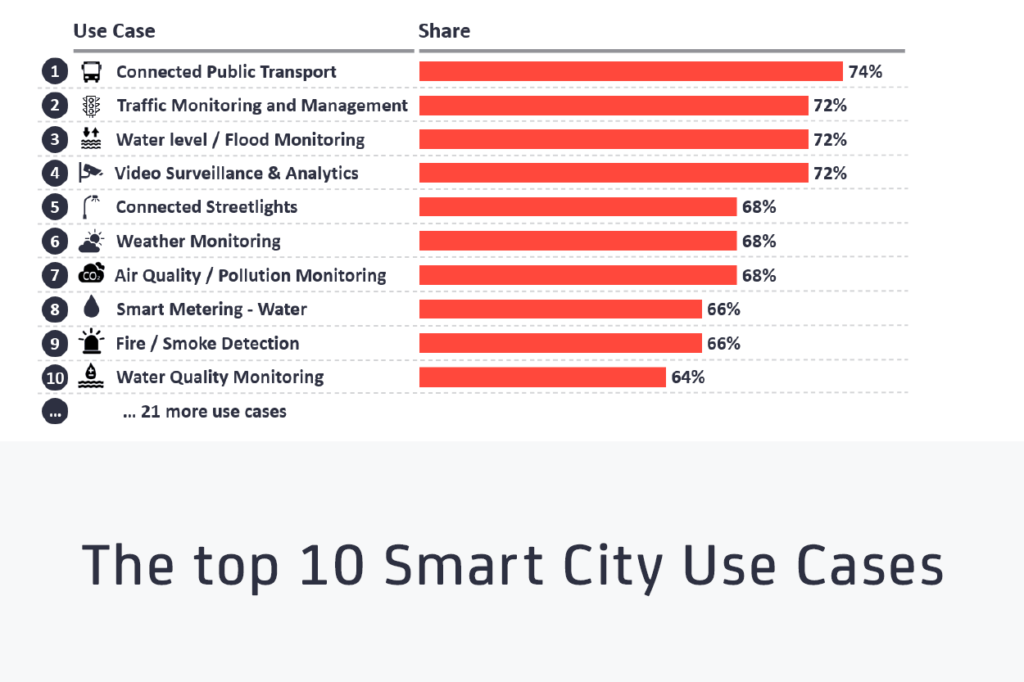
Copenhagen, Denmark: Copenhagen is recognized as a global leader in smart city initiatives, including smart city lighting. The city has installed over 20,000 smart LED streetlights equipped with sensors and connected to a centralized management system. These lights can be remotely controlled and adjusted based on real-time conditions, optimizing energy consumption. Copenhagen’s smart lighting system has resulted in significant energy savings, reduced maintenance costs, and improved safety and comfort for residents and visitors.
Barcelona, Spain: Barcelona has deployed an extensive smart city lighting network that encompasses not only energy efficiency but also a range of smart services. The city has installed over 18,000 LED streetlights equipped with sensors that monitor air quality, noise levels, and temperature. The lighting infrastructure also incorporates Wi-Fi access points and smart parking sensors. Barcelona’s smart lighting system has improved energy efficiency, reduced light pollution, and provided valuable data for urban planning and decision-making.
Los Angeles, USA: Los Angeles has undertaken a large-scale initiative to upgrade its street lighting infrastructure to LED technology. The project involves replacing over 200,000 streetlights with smart LED fixtures that can be remotely controlled and monitored. The new lighting system has resulted in significant energy savings, estimated at over $10 million annually. Moreover, the city is utilizing the lighting infrastructure to deploy additional smart city services, such as environmental monitoring and traffic management.
Adelaide, Australia: Adelaide has implemented an innovative smart lighting project called “Smart City Adelaide.” The city has replaced traditional streetlights with energy-efficient LED fixtures equipped with motion sensors and wireless connectivity. The lighting system automatically adjusts brightness levels based on real-time conditions and pedestrian activity. The project has not only improved energy efficiency but also enhanced safety and security in public spaces, promoting a vibrant and liveable city.
Singapore: Singapore has been at the forefront of smart city development, including smart lighting solutions. The city-state has implemented a comprehensive smart lighting system that covers streets, buildings, and public spaces. The lighting infrastructure incorporates advanced sensors, data analytics, and AI algorithms to optimize lighting levels and detect faults or anomalies. Singapore’s smart lighting system has not only improved energy efficiency but also enhanced the city’s aesthetics, safety, and overall urban experience.
These case studies demonstrate the successful implementation of smart city lighting solutions in diverse urban contexts. The adoption of intelligent lighting infrastructure has resulted in significant energy savings, improved safety, enhanced aesthetics, and enabled the deployment of additional smart services. These success stories serve as inspiration and provide valuable insights for other cities looking to embark on similar smart city lighting initiatives.
- 8. Future Frontiers: Unveiling Possibilities
As technology continues to advance at a rapid pace, the future of smart city lighting holds exciting possibilities. Emerging technologies and innovative ideas are set to revolutionize urban lighting systems, offering even greater efficiency, functionality, and sustainability. Let’s explore some future frontiers and potential developments in smart city lighting:
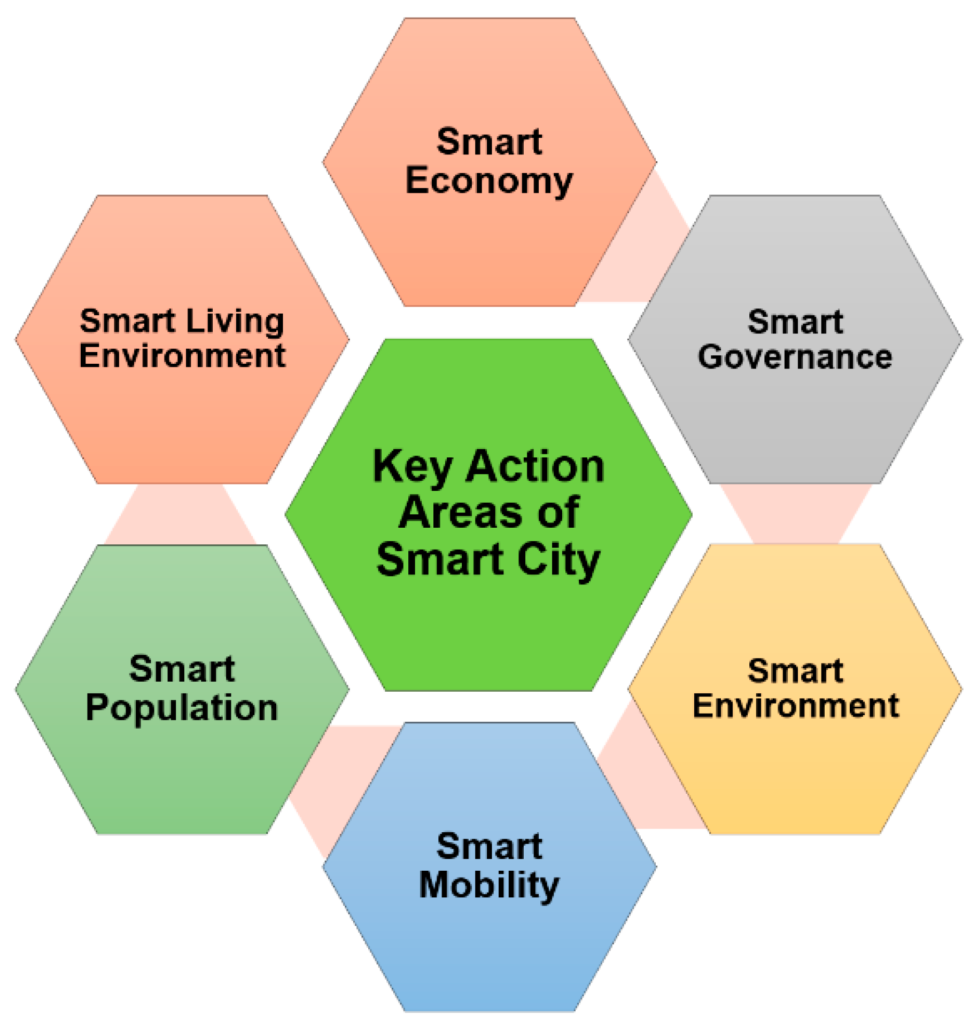
Connected and Adaptive Lighting Networks: Future smart city lighting systems will be more interconnected, forming a network of intelligent lights that communicate with each other and respond dynamically to changing conditions. These systems will utilize advanced sensors, AI algorithms, and data analytics to optimize lighting levels, detect faults, and predict maintenance needs. Connected lighting networks will enable cities to achieve even greater energy savings, reduce light pollution, and provide personalized lighting experiences.
Internet of Things (IoT) Integration: The integration of smart city lighting with the Internet of Things (IoT) will unlock new possibilities for data-driven decision-making and automation. Lighting fixtures will become nodes in a vast IoT ecosystem, collecting and transmitting data on various urban parameters, such as air quality, traffic flow, and noise levels. This data will enable cities to gain real-time insights, optimize resource allocation, and enhance overall urban planning and management.
Li-Fi Technology: Li-Fi, or Light Fidelity, is an emerging technology that utilizes light waves to transmit data, providing wireless connectivity through smart lighting infrastructure. Li-Fi has the potential to revolutionize communication and connectivity within cities. Smart city lighting equipped with Li-Fi technology can provide high-speed internet access, enabling seamless connectivity for residents, businesses, and IoT devices. This technology opens up new opportunities for innovative applications, such as smart transportation, augmented reality, and real-time data exchange.
Sustainable and Energy-Harvesting Solutions: Future smart city lighting systems will place an even greater emphasis on sustainability and energy efficiency. Advancements in energy-harvesting technologies, such as solar panels integrated into lighting fixtures, will enable self-sustaining lighting infrastructure. Energy-efficient LED technology will continue to evolve, offering even higher levels of efficiency and longer lifespans. Additionally, smart city lighting systems will leverage renewable energy sources and intelligent energy management systems to further reduce environmental impact and dependence on traditional power grids.
Augmented Reality and Interactive Lighting Experiences: As augmented reality (AR) technologies become more prevalent, smart city lighting can be integrated with AR applications to provide interactive and immersive experiences. Lighting fixtures equipped with sensors and projection capabilities can create augmented environments, overlaying digital information and virtual elements onto the physical urban landscape. This opens up possibilities for interactive art installations, wayfinding, historical storytelling, and engaging educational experiences.
Human-Centric Lighting Design: Future smart city lighting will focus on human-centric lighting design, taking into account the physiological and psychological effects of light on human well-being. Lighting systems will be designed to mimic natural daylight patterns, adjusting colour temperature and intensity throughout the day to support circadian rhythms and promote better sleep quality. This approach to lighting design will contribute to improved health, productivity, and overall quality of life for urban dwellers.
The future of smart city lighting is incredibly promising, with advancements in technology paving the way for more efficient, sustainable, and intelligent lighting systems. These developments will transform urban environments, enhancing energy efficiency, safety, aesthetics, and the overall urban experience. As cities embrace these future frontiers, they will create smarter, more liveable, and sustainable urban spaces for generations to come.
In addition to the benefits already stated, ILLUSTRIOUS Technologies India Pvt Ltd’s Smart City Lighting solutions let companies take advantage of advance technological tools and best smart city lighting consultancy. please get in touch with us www.illustrious.co.in or write to us if you need any assiatance or consultation for Smart City Lighting products and solutions.

need more details on AI tools and techniques used for smart city lighting. kindly provide details if possible.
Thanks for your interest. kindly share your email id so that we can provide you more details as requested by you. Regards, Sanjeev